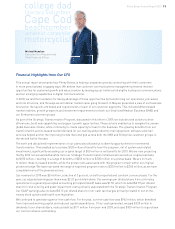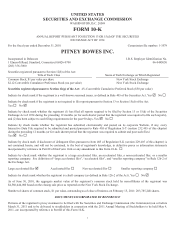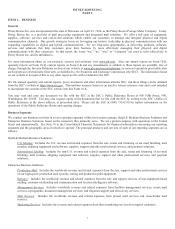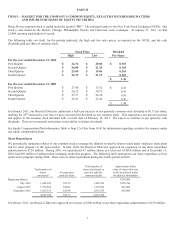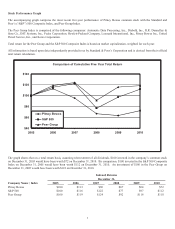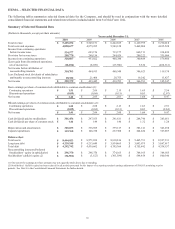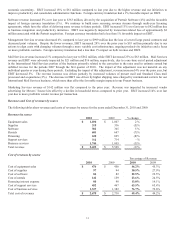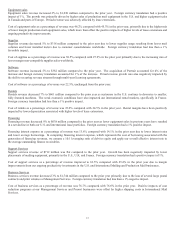Pitney Bowes 2010 Annual Report Download - page 24
Download and view the complete annual report
Please find page 24 of the 2010 Pitney Bowes annual report below. You can navigate through the pages in the report by either clicking on the pages listed below, or by using the keyword search tool below to find specific information within the annual report.5
Regulatory Matters
We are subject to the regulations of postal authorities worldwide, related to product specifications and business practices involving our
postage meters. From time to time, we will work with these governing bodies to help in the enhancement and growth of mail and the
mail channel. See “Legal Proceedings” in Item 3 of this Form 10-K.
Employees and Employee Relations
At December 31, 2010, we employed approximately 21,600 persons in the U.S. and 9,100 persons outside the U.S. The large majority
of our employees are not represented by any labor union, and we believe that our current relations with employees are good.
Management follows the policy of keeping employees informed of decisions, and encourages and implements employee suggestions
whenever practicable.
Executive Officers
See Part III, Item 10. “Directors, Executive Officers and Corporate Governance” of this Form 10-K for information about Executive
Officers of the Registrant.
ITEM 1A. – RISK FACTORS
In addition to other information and risk disclosures contained in this Form 10-K, the risk factors discussed in this section should be
considered in evaluating our business. We work to manage and mitigate these risks proactively, including through our use of an
enterprise risk management program. In our management of these risks, we also evaluate the potential for additional opportunities to
mitigate these risks. Nevertheless, the following risks, some of which may be beyond our control, could materially impact our brand
and reputation or results of operations or could cause future results to differ materially from our current expectations:
Our revenue and profitability could be adversely affected by changes in postal regulations and processes.
The majority of our revenue is directly or indirectly subject to regulation and oversight by postal authorities worldwide. We depend
on a healthy postal sector in the geographic markets where we do business, which could be influenced positively or negatively by
legislative or regulatory changes in those countries. Our profitability and revenue in a particular country could be affected by adverse
changes in postal regulations, the business processes and practices of individual posts, the decision of a post to enter into particular
markets in direct competition with us, and the impact of any of these changes on postal competitors that do not use our products or
services. These changes could affect product specifications, service offerings, customer behavior and the overall mailing industry.
An accelerated decline in the use of physical mail could adversely affect our business.
Changes in our customers’ communication behavior, including changes in communications technologies, could adversely impact our
revenue and profitability. Accelerated decline in physical mail could also result from government actions such as executive orders,
legislation or regulations that mandate electronic substitution, prohibit certain types of mailings, increase the difficulty of using
information or materials in the mail, or impose higher taxes or fees on mailing or postal services. While we have introduced various
product and service offerings as alternatives to physical mail, we face competition from existing and emerging products and services
that offer alternative means of communication, such as email and electronic document transmission technologies. An accelerated
increase in the acceptance of electronic delivery technologies or other displacement of physical mail could adversely affect our
business.
Reduced confidence in the mail system could impact our mail volume.
Unexpected events such as the transmission of biological or chemical agents, or acts of terrorism could have a negative effect on
customer confidence in a postal system and as a result adversely impact mail volume. An unexpected and significant interruption in
the use of the mail could adversely affect our business.
We depend on third-party suppliers and our business could be adversely affected if we fail to manage suppliers effectively.
We depend on third-party suppliers for a variety of services, components, supplies and a portion of our product manufacturing. In
certain instances, we rely on single sourced or limited sourced suppliers around the world because the relationship is advantageous due
to quality, price, or there are no alternative sources. If production or service was interrupted and we were not able to find alternate
suppliers, we could experience disruptions in manufacturing and operations including product shortages, higher freight costs, and re-
engineering costs. This could result in our inability to meet customer demand, damage our reputation and customer relationships and
adversely affect our business.



